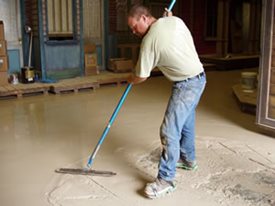
Decorative Concrete Institute in Temple, GA
Many concrete repair and resurfacing contractors are being kept busy by homeowners who attempted to spruce up a worn concrete patio, driveway, or indoor floor with a decorative overlay but botched the job badly. Unfortunately, this is a scenario that’s becoming all too common as more homeowners watch online tutorials showing how “easy” it is to install an overlay as a cost-cutting do-it-yourself project.
Find contractors: Concrete resurfacing near me
Sure, a DIY concrete resurfacing video may make the process look simple. But it’s far from enough to fully prepare an inexperienced homeowner to do the job correctly. From prep work, to placement, to final finishing, putting down a concrete overlay can be tricky and it takes time and experience to master the techniques required.
1. Good Surface Prep Is Key
Although an overlay can disguise some surface imperfections in concrete, such as stains and hairline cracks, it can’t correct major damage or adhere to a deteriorating base layer. An expert can identify these issues and will know what surface prep is required to ensure a successful outcome. Overlooking the prep work, or not doing the job right, is the most common cause of overlay failure.
Learn more about preparing concrete for resurfacing.
2. The Right Equipment Is Essential
Homeowners have to be willing to invest in the right equipment if they want to achieve a successful outcome when resurfacing concrete. Although it may be possible to rent the needed tools, experienced contractors already have the proper equipment, most of which can be quite expensive, such a concrete grinder or shotblaster to mechanically abrade the concrete and achieve the right surface profile for overlay adhesion and a pressure washer to remove any residue. This equipment can also be difficult to operate and can damage the concrete if used too aggressively.
Get tips for pressure washing concrete driveways, sidewalks, and patios.
3. There Is No Room for Error
Once an overlay is placed, the installation is permanent and major mistakes made along the way usually can’t be fixed without removing it entirely and starting over (see Fixing Concrete Overlays). Most professional installers have the experience and knowledge it takes to get the job done right the first time. Many will also guarantee their materials and workmanship.